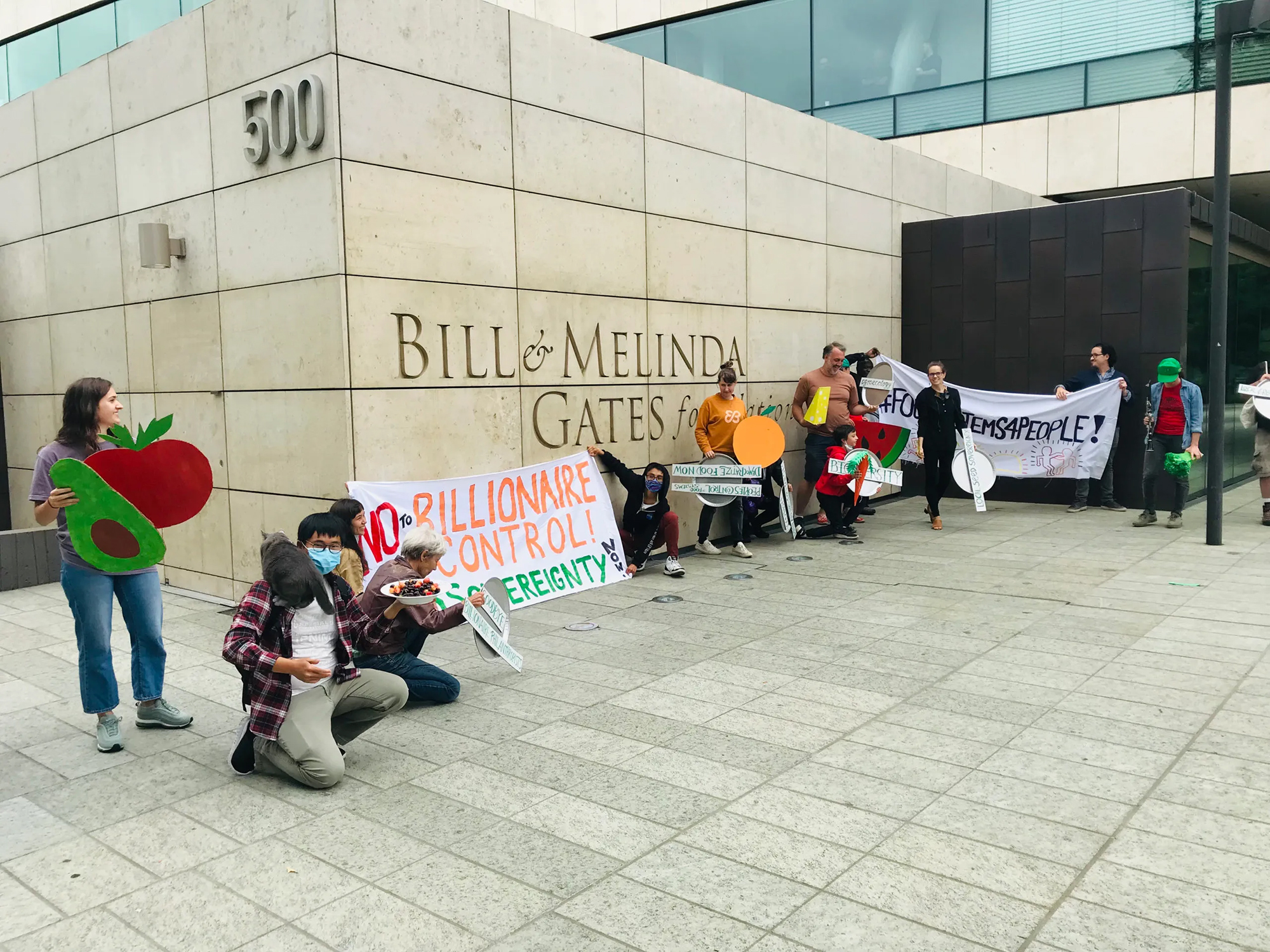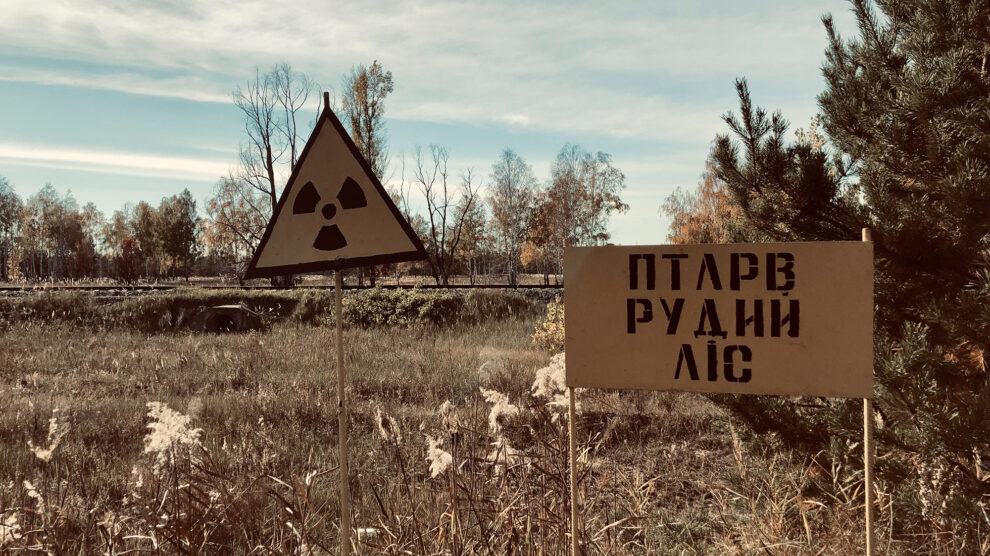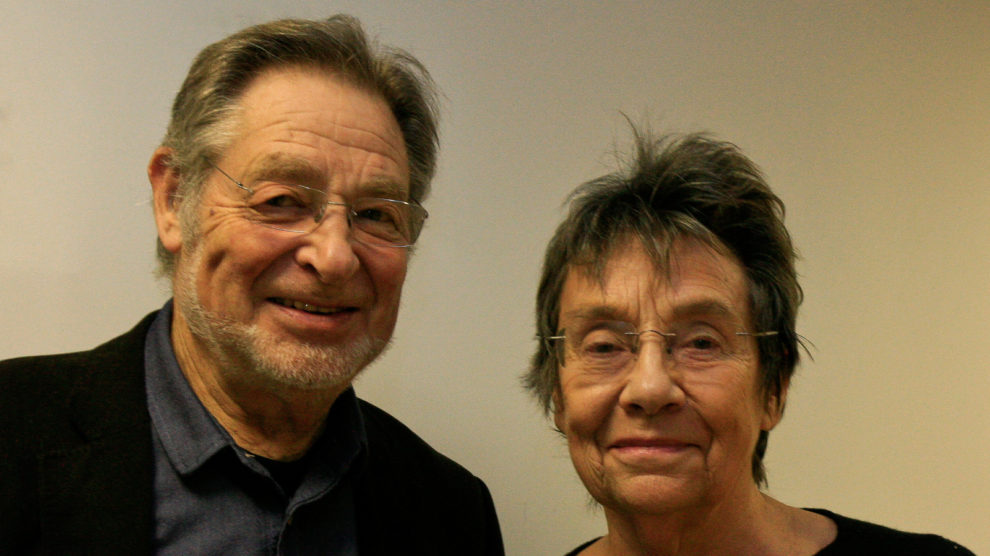The New “Green Revolution” for Africa: A Revolution for Farmers, or for Corporate Profits?
An interview with Daniel Maingi
By Ashley Fent
Volume 25, no. 1, The Soil and the Worker

In 2006, the Gates Foundation and the Rockefeller Foundation created the Alliance for a Green Revolution in Africa (AGRA) with an initial grant of $150 million, claiming to help African farmers and transform African agriculture.1 Over the past fifteen years, the Gates Foundation and other smaller donors (including Canadian, US, British, and German development agencies) have contributed nearly $1 billion to AGRA.2
We in the Community Alliance for Global Justice first became aware in 2007 that the Gates Foundation was promoting this new and problematic “green revolution.” In response, we founded AGRA Watch in 2008, as a campaign of Community Alliance for Global Justice (CAGJ), a Seattle-based nonprofit that emerged after the WTO protests in 1999, with the aim of continuing to challenge US and corporate hegemony over trade and food systems.3 Over the past thirteen years, AGRA Watch has monitored and researched the Gates Foundation and AGRA, issued public statements and reports, mobilized community members through demonstrations and protests, and developed campaigns in close consultation with partners in Africa, including the Alliance for Food Sovereignty in Africa (AFSA), which regroups civil society organizations and networks that together represent over two hundred million small-scale food producers on the African continent.4 We engage in regular exchange with AFSA and its member organizations, and hosted a broader discussion about food sovereignty in Seattle in 2014 that included members of AFSA, La Via Campesina, and other African farmer associations.
AGRA has long been criticized by civil society organizations and farmers’ associations in Africa, on numerous grounds. AGRA’s promotion of industrial agriculture has systematically undermined food sovereignty, or the right of people to define their own food systems and ensure healthy and culturally appropriate food, produced through ecologically sound and sustainable methods. By contrast, the US-style industrial agriculture model AGRA pushes in Africa enables large agribusiness corporations and private companies to gain a foothold in African agriculture—now seen by many investment and business consulting firms as a new frontier for growth.5 AGRA has also come under fire for promoting genetically-modified organisms (GMOs), both overtly and more subtly as part of an increasing emphasis on “climate-smart agriculture.” Attempting to create business opportunities in African agriculture, AGRA has directed funding to groups that push for national seed privatization laws, pro-GMO biosafety laws, and fertilizer laws that open African markets. Additionally, AGRA is non-transparent in its grantmaking, decision-making, and monitoring and evaluation of its programs.6 And while AGRA claims to be African-led, it is legally registered in the US and fewer than half of its board members are African (at the time of this writing). It also claims to help smallholder farmers, but most of the farmers who are able to take advantage of AGRA’s interventions and programs are larger-scale, better-resourced commercial farmers.7 After fifteen years, it is clear that AGRA has even failed to meet its own objectives. Yields remain comparatively low when small-scale farmers apply Green Revolution technology, and malnutrition, hunger, and poverty have in many cases increased in the countries where it operates.8
AGRA is part of a much larger ecosystem of investors, philanthropic foundations, and corporations working together to pressure African governments to open up new markets for industrial and chemical-intensive agriculture (and attendant devices, tools, and technologies) in Africa. As one of the largest private philanthropic foundations in the world, the Bill and Melinda Gates Foundation plays an important role within this wider ecosystem, donating not only to AGRA but also to the African Agricultural Technology Foundation (AATF), the African Biosafety Network of Expertise (ABNE), and numerous other pro-agribusiness and pro-GMO initiatives, like the Cornell Alliance for Science.9 These institutions—some of which the Gates Foundation had a hand in creating in the first place—work to ensure that African smallholder farmers have very little voice over agricultural policies in their own countries.
We sat down with our friend and partner Daniel Maingi, Programs Manager at Growth Partners Africa and Coordinator of the Kenya Food Rights Alliance, to discuss the impact of the Gates Foundation and AGRA on African agriculture, smallholder farmers, and food sovereignty.
—
Ashley: The Gates Foundation’s website states: “We invest in tools, technologies, and market infrastructure to help smallholder farmers in Kenya improve their productivity and incomes and adapt to climate change.” Have you seen any evidence that their spending has helped small-scale farmers in Kenya in these ways?
Daniel: The Bill and Melinda Gates Foundation’s money has not helped small-scale farmers at all. The fertilizers, pesticides, and herbicides that their grantees have pushed have actually created more problems, like creating resistance among new pests and diseases, like Tuta absoluta (South American tomato pinworm), the African stem borer, and fall armyworm. They also created acidic soils. And that has actually resulted in a lot of yield loss to farmers.
In terms of market infrastructure, the Bill and Melinda Gates Foundation has put in a lot of money to organizations like the One Acre Fund, where they invested $11.6 million (which is about 1.1 billion Kenyan shillings). The idea is that the seeds have to be accompanied by fertilizers and specific pesticides and herbicides. A lot of the One Acre Fund farmers have actually gone into debt.
Ashley: How has the Gates Foundation influenced agricultural policies in Kenya? What do these policies mean for farmers?
Daniel: The Bill and Melinda Gates Foundation has been exacting undue influence on local and regional policy makers. Right from the start, they gave Michigan State University about $13 million to establish a training policy center for African biotechnology leaders, so that they can influence the process and the debate around biotechnology. Closer back home [in Kenya], the African Seed Trade Association has received a lot of money from the Gates Foundation to convince farmers to replace their indigenous seed with seed that is coming from corporations and conglomerates. The African Agricultural Technology Fund (AATF) has received $27 million to influence the adoption of genetically-modified maize in four African countries, and another $32 million to educate and create awareness about the benefits of biotechnology. This is a lot of money that, if it is going to the biosafety organizations in these countries, it’s more than what governments actually give. Gates’s money, combined with World Bank money, also ran another project called Enabling the Business of Agriculture in Africa.10 And that unfortunately is also another area where many countries and organizations are forcing governments to weaken biosafety regulations and create markets for biotechnology products. That money, when it is spread to influence policy, means that every other national organization will have to yield and [follow along]. AGRA and organizations that are funded by the Bill and Melinda Gates Foundation get easier access to the government than other organizations like my own. When we go to the government for policy or services, they’re listened to before we even get any admission. And so, definitely, it’s been one of the bad influences in this area. That needs to be changed, such that all players are given equal time to be listened to by the government and decision-makers.
Ashley: Speaking of biotechnology, how have you seen discussions about GMOs in Kenya change as a result of involvement by the Gates Foundation, AGRA, AATF, and other institutions?
Daniel: Because of the monies that have been advanced to so many organizations that support and work with the industry, such as AATF and AGRA, the conversation around biotechnology products, especially GMOs, has been lopsided. And we are finding that those that make it to the newspapers with the stories of benefits are those that have been influenced by the money coming from the Bill and Melinda Gates Foundation. The Open Forum for Agricultural Biotechnology (OFAB), which is a project by AATF, has been one of the key areas where government and policymakers have been told about the benefits of biotechnology and GMOs. And particularly at this time when maize, cotton, and cassava are in the pipeline of being released, the attendance by government officers in OFAB has definitely shifted the debate towards approving [GMOs]. And the side of smallholder farmers is not being listened to, the side of all other thinkers has been totally ignored because of the huge funds that have come from the Bill and Melinda Gates Foundation.
Ashley: They claim that GMOs will help small-scale farmers. Is that true?
Daniel: One of the biggest investments by the foundation in AGRA, AATF, and a few other organizations has been focused on Water Efficient Maize for Africa (WEMA). In 2015, about twenty-five new varieties were released through this project. And we’ve had over five years to compare WEMA maize with regular maize that farmers have planted, including maize that came from publicly funded organizations, and older varieties. Farmers have planted WEMA maize side by side with these other varieties, and the yields [of WEMA] are not as good, the produce doesn’t keep as well, the taste is not as good as many smallholder farmers are used to. And when there’s drought, there’s no difference [in yield] at all. To cope with drought, many of the farmers have actually been using organic manure and mulching. And this is resulting in more water retention in the soil—benefiting the maize—than the engineered technology for water efficiency in maize. So definitely the GMOs have not helped and we don’t think that any of them will help in the time to come.
Ashley: AGRA invested approximately $55 million in Kenya between 2008 and 2016.11 In more recent years, AGRA has begun emphasizing regenerative agriculture and conservation agriculture in their grants.12 Do these investments actually support agroecology and/or small-scale farmers in Kenya?
Daniel: The conversations on agroecology and regenerative agriculture are slowly being hijacked by industrial players and agribusiness promoters. The Bill and Melinda Gates Foundation has been funding organizations that are now beginning to use a lot of their money to talk about agroecology, but using [industrial agriculture and biotechnology] products. So it is like planting GMO maize, but also using mulch or organic manure, because there’s a recognition that fertilizers are failing and smallholder farmers have been succeeding using organic manure. When you use organic manure, mulching, and cover crops, which are part and parcel of regenerative and conservation agriculture, you get a better yield. But now, when you talk about conservation agriculture, they want you to use GMO maize. So, that hijacking of regenerative practices, we’re beginning to see it. And of course, at the end of the day, it is the corporations and conglomerates that are ending up being the beneficiaries.
Ashley: Over the past couple of years, the Microsoft 4Afrika initiative—created in 2013 to invest in making Africa a “cloud-forward” and technology-based continent—has been partnering with AGRA, the Kenyan government, and the World Bank to increase digital technology applications in agriculture.13 How have or will digital technologies impact farmers?
Daniel: When it comes to digital technologies in agriculture in Africa, Kenya is at the apex of all sorts of trials and experimentation, mainly because we are at the leading edge of adopting technologies and adopting [mobile] money products in order to change our livelihoods. We’ve seen all sorts of apps and new digital products. And we know for sure that they’re not going to benefit the smallholder farmer in the near future, because many of these are very expensive technologies. We know for sure farmers will not be using robotics in farming. And even if they use digital apps that can take pictures and record their yield, the problem is actually bigger than just yield. It is markets, it is what farmers are culturally used to, and it is what they are able to do. It will not make any extra money for many farmers if they’re able to use a tractor with GPS locations. Instead, the benefits of adopting digital agriculture end up going to the manufacturers of the technologies, whether they’re tractors or GPS robotics, or even the precision [agriculture] people. All of this is actually just a way of creating a story to say that this is now the way to go and if you don’t talk about digital technology, you’re behind. That does not create sovereignty, and it does not make farmers more resilient to climate change.
—
In Africa and around the world, farmers are already practicing agroecology and other sustainable local and Indigenous models of food production. The Kenya Food Rights Alliance, with whom Daniel works, is dedicated to championing food rights and ensuring that all human beings are free from hunger, food insecurity, and malnutrition. They, along with AFSA member organizations and many other groups and organizations on the continent, are leading critical efforts to promote and advance alternatives that achieve a holistic vision of food self-sufficiency and self-determination, while fighting against the spread of corporate-controlled, climate-insensitive industrial agriculture.
Notes
- Anuradha Mittal and Melissa Moore, eds., Voices from Africa (Oakland: Oakland Institute, 2009), https://www.oaklandinstitute.org/sites/oaklandinstitute.org/files/voicesfromafrica_full.pdf.
- Timothy A. Wise, Failing Africa’s Farmers: An Impact Assessment of the Alliance for a Green Revolution in Africa, Global Environment and Development Working Paper No. 20-01. (Medford, MA: Tufts University, 2020), https://sites.tufts.edu/gdae/files/2020/07/20-01_Wise_FailureToYield.pdf.
- https://cagj.org/agra-watch/; https://cagj.org/
- Examples at https://cagj.org/agra-watch/media/: analysis of the Cornell Alliance for Science; analysis of the Gates Foundation’s influence on the UN Food Systems Summit. Video from a couple of our 2021 events is also available here: webinar and participatory theater.
- Lutz Goedde, Amandla Ooko-Ombaka, and Gillian Pais, “Winning in Africa’s agricultural market,” McKinsey and Company, February 15, 2019, https://www.mckinsey.com/industries/agriculture/our-insights/winning-in-africas-agricultural-market.
- Timothy A. Wise, “AGRA Update: Withheld Internal Documents Reveal No Progress For Africa’s Farmers,” IATP, February 25, 2021, https://www.iatp.org/blog/202102/agra-update-withheld-internal-documents-reveal-no-progress-africas-farmers.
- Neil Dawson, Adrian Martin, and Thomas Sikor, “Green Revolution in Sub-Saharan Africa: Implications of Imposed Innovation for the Wellbeing of Rural Smallholders,” World Development 78 (2016): 204–218, https://www.sciencedirect.com/science/article/pii/S0305750X15002302; James Boafo and Kristen Lyons, “Ghana’s farmers aren’t all seeing the fruits of a Green Revolution,” The Conversation, June 14, 2021, https://theconversation.com/ghanas-farmers-arent-all-seeing-the-fruits-of-a-green-revolution-162345.
- Alliance for Food Sovereignty in Africa et al. A Sting in the AGRA Tale: Independent Expert Evaluations Confirm That the Alliance for a Green Revolution Has Failed (2021), https://www.rosalux.de/fileadmin/rls_uploads/pdfs/engl/AGRA_Sting_in_the_AGRA_Tale_ENG_20210721.pdf; Lena Basserman and Jan Urhahn, False Promises: The Alliance for a Green Revolution in Africa (2020), https://www.rosalux.de/fileadmin/rls_uploads/pdfs/Studien/False_Promises_AGRA_en.pdf.
- AGRA Watch, Messengers of Gates’ Agenda: A Case Study of the Cornell Alliance for Science Global Leadership Fellows Program (Seattle: CAGJ, 2020), https://cagj.org/wp-content/uploads/Messengers-of-Gates%E2%80%99-Agenda-A-Case-Study-of-the-Cornell-Alliance-for-Science-Global-Leadership-Fellows-Program.pdf.
- Matt Canfield, “Why do the World Bank’s new indicators, ‘Enabling the Business of Agriculture’ pose a threat to African agriculture?” CAGJ Blog, January 19, 2017, https://cagj.org/2017/01/why-do-the-world-banks-new-indicators-enabling-the-business-of-agriculture-pose-a-threat-to-african-agriculture/.
- Basserman and Urhahn, False Promises.
- “Farmers in Laikipia County multiplying yields,” AGRA, December 18, 2018, https://agra.org/impact-story-1/; “Regenerative Agriculture Unlocks Business Opportunities for Rural Communities in Embu, Kenya,” AGRA, October 29, 2021, https://agra.org/regenerative-agriculture-unlocks-business-opportunities-for-rural-communities-in-embu-kenya/; Annual Report (Nairobi: AGRA, 2020), https://agra.org/wp-content/uploads/2021/07/AGRA-Annual-Report-2021-15-07-2021-02.pdf.
- Bob Koigi, “Kenya government partners with Microsoft to accelerate use of tech in agriculture,” Africa Agribusiness, March 19, 2020, https://africabusinesscommunities.com/agribusiness/news/kenya-government-partners-with-microsoft-to-accelerate-use-of-tech-in-agriculture/;”Our Story,” 4Afrika, https://www.microsoft.com/africa/4afrika/about-us.aspx.





